Among the great European museums, Lisbon ’s Museu Nacional de Arte Antiga plays the part of the Cinderella: little known, it is certainly not one of the most popular destinations for international tourists passing through the Portuguese capital. Inside, however, it holds wonderful masterpieces and offers countless reasons to visit. It was established in 1884 to collect the countless art treasures of the religious guilds suppressed in 1834. Decisive for the opening of the museum was the success of the retrospective exhibition of Portuguese art and Spanish ornamental art held in 1881 at London’s South Kensington Museum, now the Victoria & Albert Museum.
The museum’s home was located in an aristocratic residence, built in the late 17th century, called the Alvor Pombal Palace, named after the first owner, the Count of Alvor and the brother of the Marquis of Pombal (the architect of Lisbon’s reconstruction after the terrible earthquake of 1774) who bought it in 1759. The palace that rests on the banks of the Tagus River was enlarged with the acquisition also of the perimeter Convento das Albertas, where in the meantime the order of Discalced Carmelite nuns that inhabited it had died out.
Inside, it is possible to admire the entire development of Portuguese art, something that unfortunately is not as easy to do in Lisbon’s churches, which were impoverished of much of the oldest evidence after the destructive earthquake of 1774. But the MNAA also holds within it remarkable masterpieces of European art, commissioned by religious guilds, or belonging to nobles and royal collections.
It is not surprising that, in a deeply Catholic nation like Portugal, most of the most valuable works were for a long time linked to religious commissions. In contrast, greater compositional and decorative freedom was possible for Portuguese artists in the applied arts, where European Baroque and neoclassical influences are mediated with a lively coloristic panache that is uniquely Portuguese, which can be admired here.
 |
| Interior of the museum |
 |
| Museum interior |
 |
| The Museum’s garden overlooking the Tagus River |
 |
| The garden of the Museum overlooking the Tagus River |
 |
| Hall with tapestry and robbiane |
 |
| Antenor Patiño Hall |
 |
| Hall of the Portuguese Baroque |
The large museum is spread over three floors, divided into 70 exhibition rooms. The ground floor and mezzanines are dedicated to hosting temporary exhibitions, as well as a number of functional rooms such as the auditorium, the library, and the Cabinet of Drawings and Prints, which is also deputed to display works on a rotating basis. Going up to the second floor, one encounters some of the most important masterpieces housed in the museum. Here paintings and sculptures are grouped in chronological order or sometimes by schools, while in still other rooms the aesthetic criterion seems to be predominant.
This is the case in the large room with the tapestry celebrating the discovery of the Indies by the Portuguese led by Captain Vasco da Gama in 1498, an episode celebrated propagandistically in numerous tapestries of the period commissioned by King Manuel I. The extraordinary tapestry vividly shows the many curiosities loaded on the ships that arrived from that mysterious and distant land, among the varied animals even a legendary unicorn. Arranged in the same room are beautiful robbiane and a polychrome sculpture depicting a Saint Leonard by Andrea delle Robbia, as well as a very fine bas-relief by Sansovino. Numerous rooms are dominated by majestic triptychs or retables, which had no small fortune in the Iberian peninsula, particularly those of the Flemish masters.
Precious, dazzling colors enhance the mournful religious scenes, where pain is rendered with great pathos and care, as in Pieter Coecke van Aelst’s triptych of the Deposition of the Cross in which a lifeless, haggard Christ is lowered with difficulty from the cross. Also extremely refined and brilliant is Jan Provoost’s Triptych of Our Lady of Mercy.
Among these marvelous devotional machines, the most famous is Hieronymus Bosch ’s disturbing triptych of the Temptations of St. Anthony. The three scenes are populated by a teeming universe of monsters, demons and other terrors among which the saint juggles. In the left panel, we see above, the saint at the mercy of demons holding him hostage in flight, and after his fall, he is supported by some men as he crosses a bridge, also a refuge of evil. In the right and middle panels, St. Anthony extricates himself from these corrupt creatures first in meditation and then in prayer.
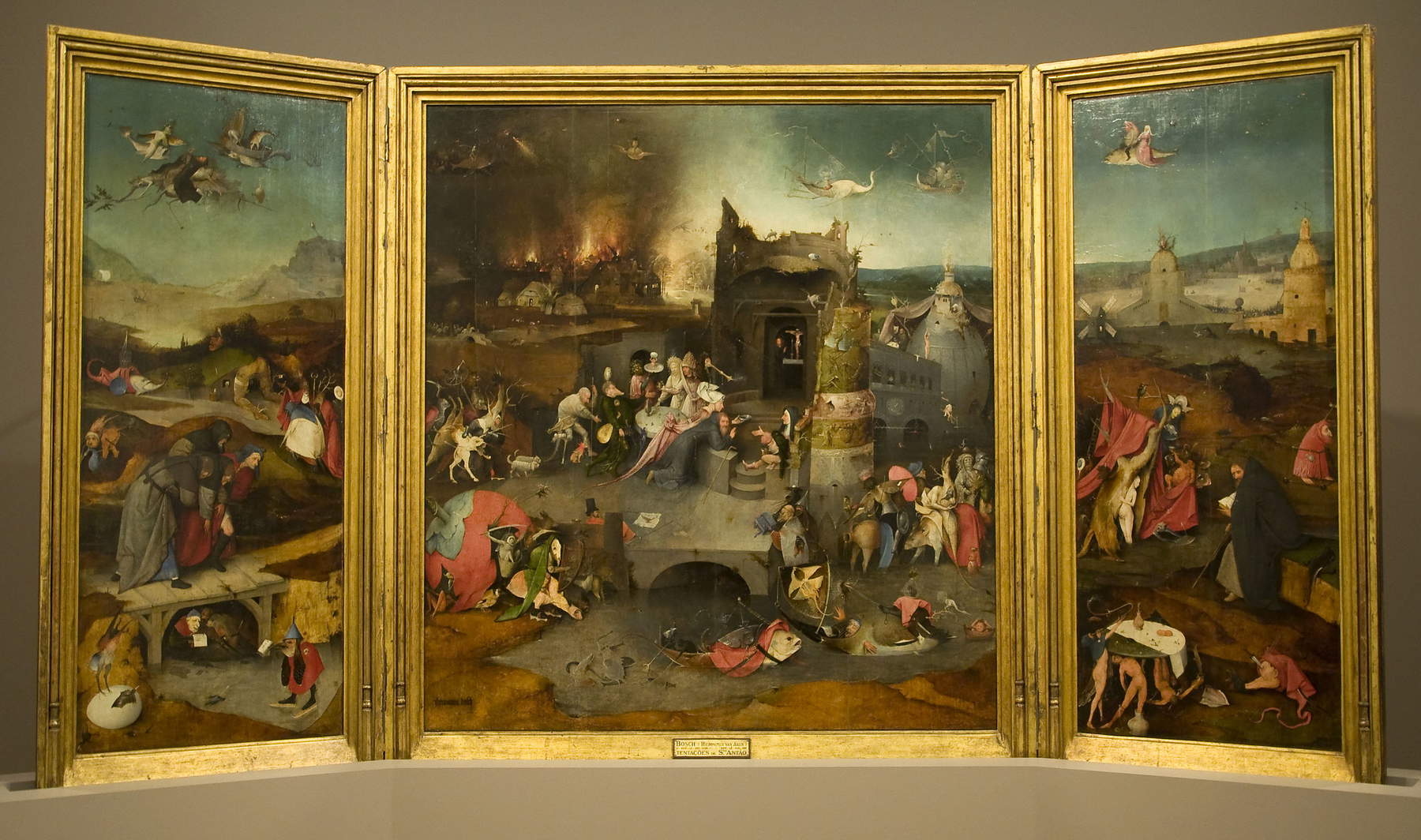 |
| Hieronymus Bosch, Triptych of the Temptations of St. Anthony (c. 1501; oil on panel, 131 x 238 cm; Lisbon, Museu nacional de arte antiga) |
 |
| Anonymous Flemish, Virgin and Child with Parrot (c. 1510-1520; oil on panel; Lisbon, Museu nacional de arte antiga) |
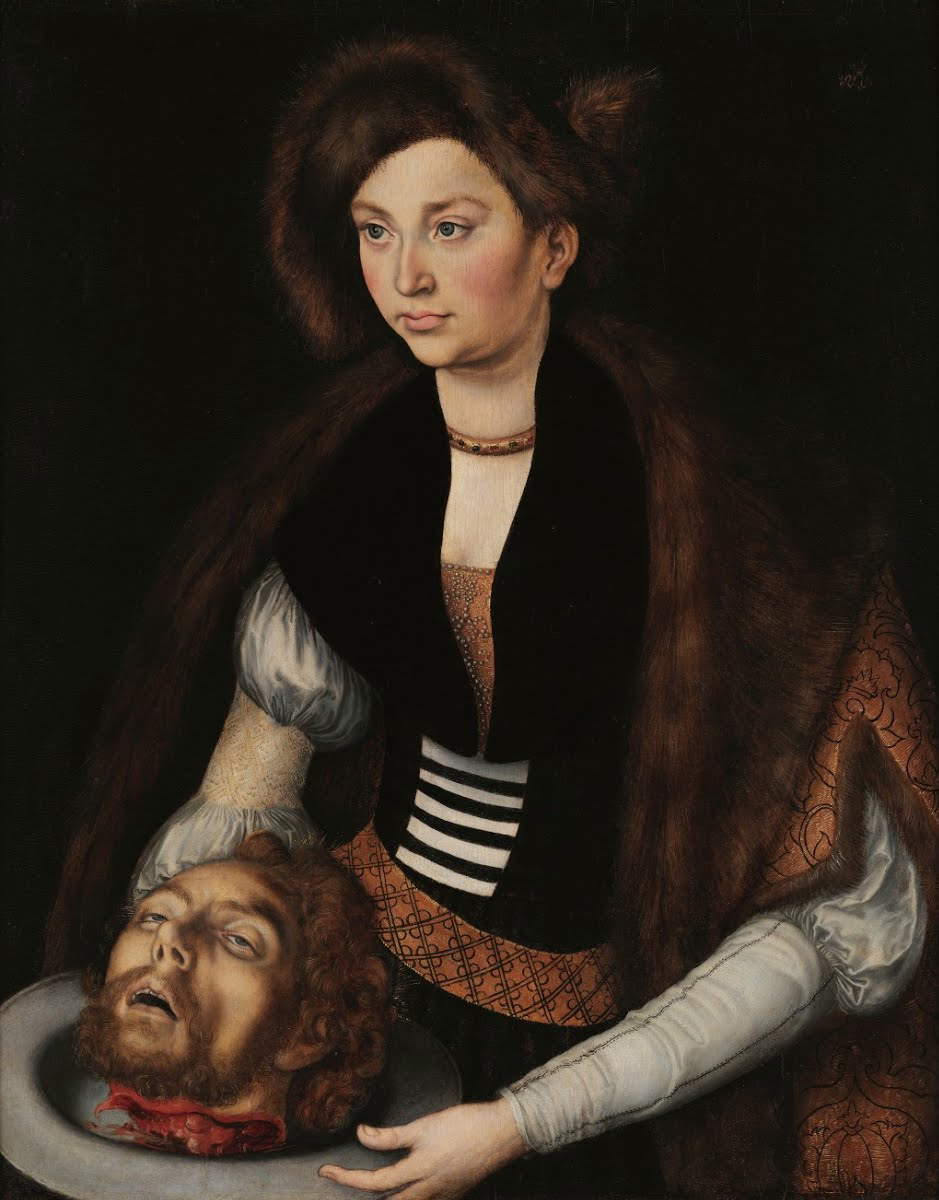 |
| Lucas Cranach the Elder, Salome with the Head of St. John the Baptist (c. 1510; oil on panel, 61 x 49.5 cm; Lisbon, Museu nacional de arte antiga) |
 |
| Albrecht Dürer, Saint Jerome in the Study (1521; oil on panel, 60 x 48 cm; Lisbon, Museu nacional de arte antiga) |
 |
| Piero della Francesca, Saint Augustine (1465; tempera on panel, 133 x 60 cm; Lisbon, Museu nacional de arte antiga) |
Among the other extraordinary works from northern Europe, a mention must be made of the works of Quentin Metsys, the brilliant progenitor of the Antwerp School, a painter active in the first three decades of the 16th century who was much sought after by the many Portuguese patrons who had substantial business interests in the Belgian port. He and his workshop were commissioned to paint the Polyptych of the Seven Sorrows of Mary for the Convent of the Mother of God in Lisbon, which was dismembered in more recent times and is largely preserved in the Portuguese museum. The typical Flemish pictorial virtuosity for textural renderings and brilliant surfaces is combined by Metsys with a more monumental rendering of the human figure, probably inferred from Italian art. In the extraordinary central panel an imposing Our Lady of Sorrows, immersed in a vivid landscape analyzed with a geological gaze, closely recalls contemporary Leonardo da Vinci. Others also include a beautiful Madonna by Hans Memling and a massive St. Luke by Hugo van der Goes, and an exquisite Madonna and Child by an anonymous artist, where the child dabbles with a Macao parrot, typical of South America, a demonstration of how receptive art had been at once to welcoming novelties from the new continent.
German artists are also equally represented: in Albrecht Dürer ’s St. Jerome, the doctor of the church is compressed into a massive, synthetic composition that enhances the essentiality of the scene, where the saint addresses the viewer, while a diagonal emphasizes the relationship between the crucifix hanging behind him and the skull, a symbol of meditation on the transience of existence. The work was created by the German during one of his trips to the Netherlands; he made some drawings and variations of it and used a ninety-three-year-old man as a model. The artist offered the painting to a legate of the Portuguese trading station in Antwerp, who took the work to Portugal a few decades later, later passing into the hands of noble owners before arriving at the museum in Lisbon.
Also famous is the painting depicting Salome with the Head of the Baptist by Lucas Cranach, who a few years later replicated the subject with a very different rendering in a work that is preserved in Budapest. The Portuguese work of 1510 marks the beginning of the popularization of the German’s painting of a female universe, where women become emblems of power and cunning (scenes with Judith, Delilah, Lucretia would follow) in which the contrast between erotic sensuality and icy female malice dominate the subjects portrayed.
Italian artists also figure well: Piero della Francesca’s Saint Augustine, part of a polyptych created by the Tuscan master for the Church of Santa Chiara in San Sepolcro, his hometown, is worth the (meager) price of the ticket alone. The saint is conceived as a solid marble statue placed in its niche, and in its masterful formal clarity it is enlivened by scenes with saints and episodes from the life of Jesus, which with incredible skill in perspective the painter has historiated on the chasuble and mitre worn by the Doctor of the Church.
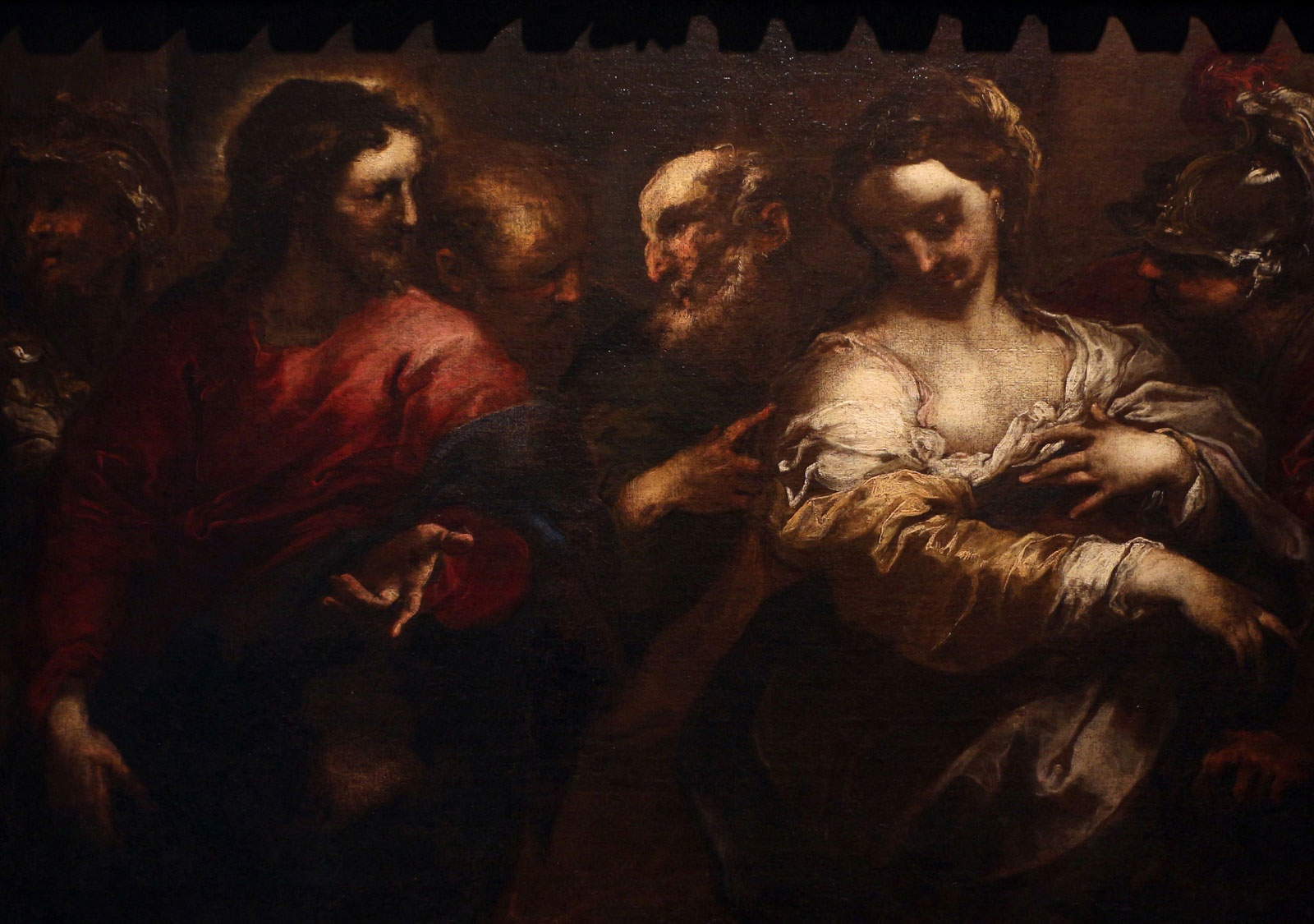 |
| Valerio Castello, Christ and Ladultera (c. 1650; oil on canvas; Lisbon, Museu nacional de arte antiga) |
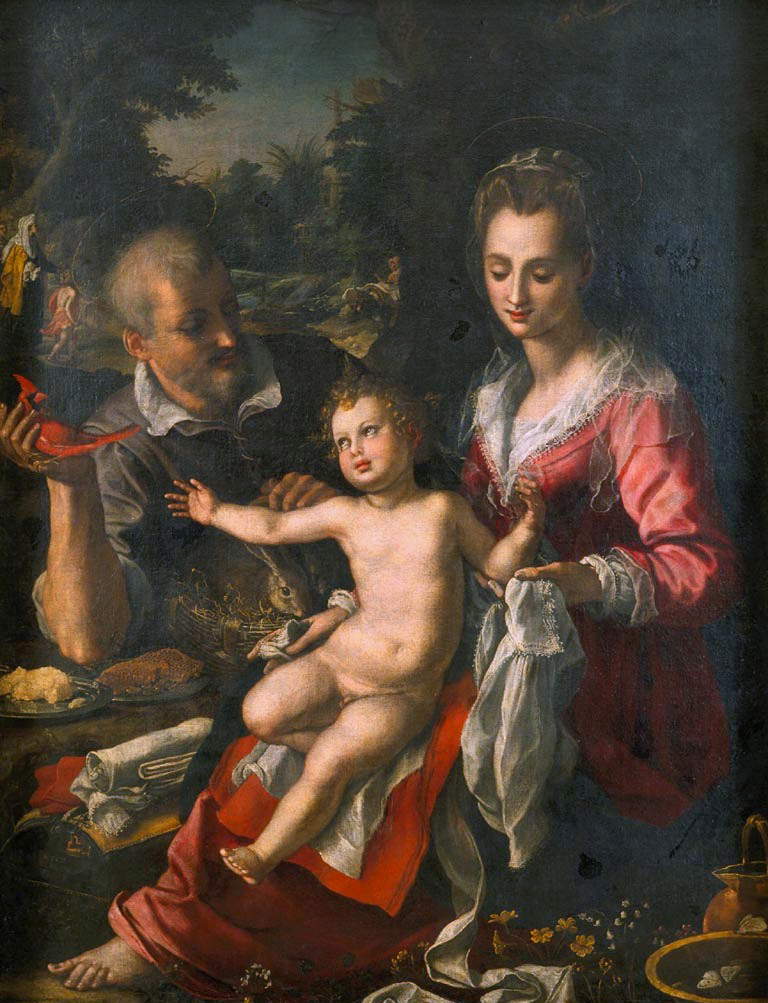 |
| Alessandro Allori, Rest during the Flight into Egypt (1602; oil on canvas, 148 x 114 cm; Lisbon, Museu nacional de arte antiga) |
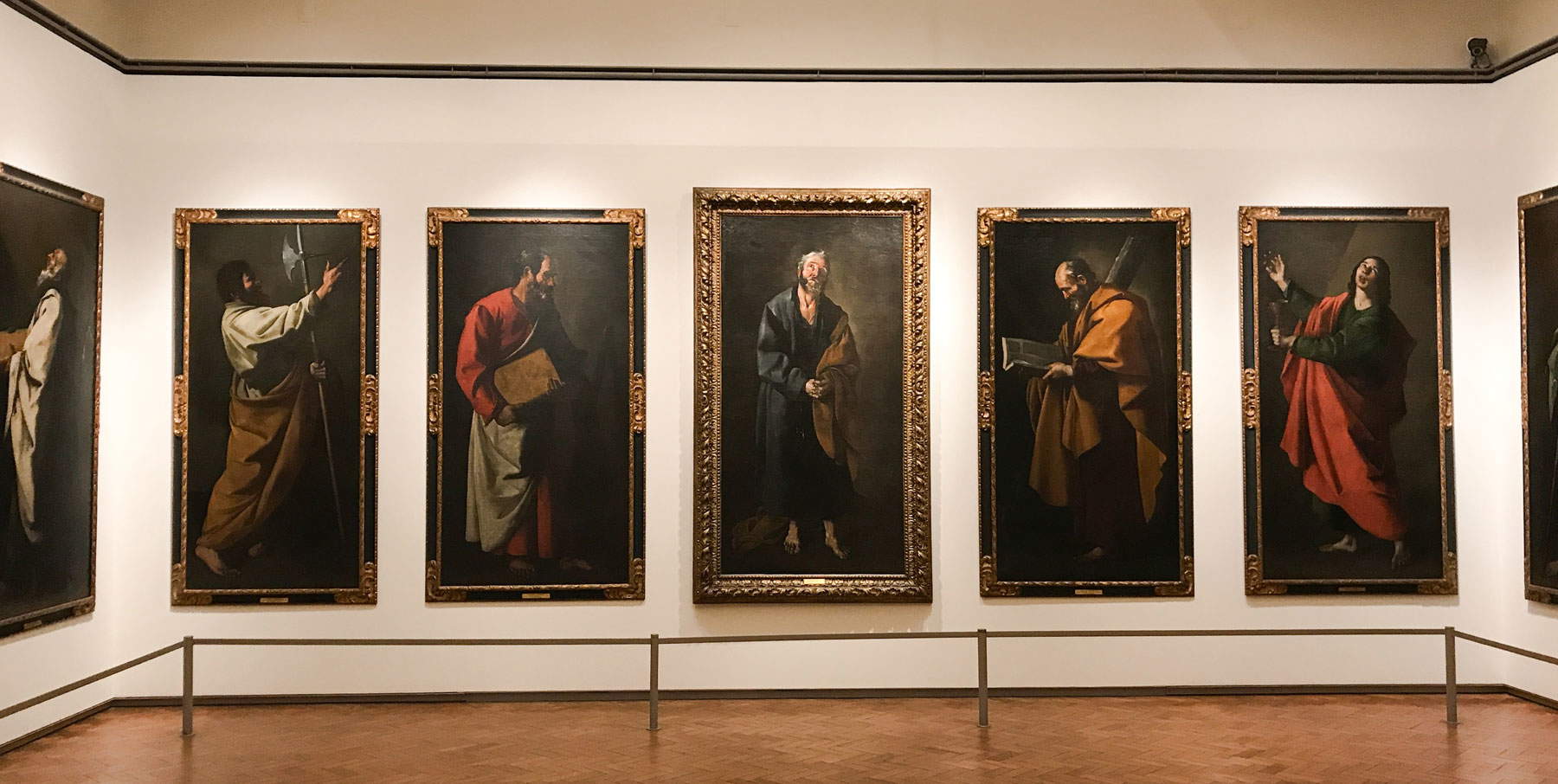 |
| The Apostles by Francisco de Zurbarán and workshop (1633) |
 |
| Gustave Courbet, Winter Landscape (1868; oil on canvas, 68 x 96 cm; Lisbon, Museu nacional de arte antiga) |
Then a predella panel painted by Raphael, paintings by Pontormo, Bronzino, Alessandro Magnasco, Luca Giordano, and many others. Also housed is a conspicuous nucleus of works by Caravaggesque artists who were well suited to the religious passions of the Portuguese clergy and aristocracy, including José Ribera, Mattia Preti, and the extraordinary cycle of apostles painted by Francisco de Zurbarán at the behest of King Philip IV of Portugal for the Monastery of São Vicente de Fora in Lisbon. A dogmatic painting daughter of the Counter-Reformation, where the plasticity of the figures is enhanced through the prodigious pictorial values of light.
An entire floor is then devoted to the precious artifacts that Portuguese sailors and merchants brought back from the many trade routes and far-flung, often plundered kingdoms that Portugal’s great naval power had reached: Chinese porcelain that with Portuguese majolica influenced each other, ivories, furniture, and carpets from colonies in the East and Africa.
The Lisbon Museum also holds the richest collection of Portuguese art in the world, from massive polychrome Romanesque sculptures, to Gothic wood carvings, to works that testify to the long-standing and enduring influence of Flemish art on Portuguese art, whose brilliance of color and realistic rendering it appreciated. The close trade relations between the Netherlands and Portugal also influenced artistic exchanges, with many Portuguese artists doing their apprenticeships in Flanders and Flemish masters moving to Portugal. The latter case involves painters such as Frei Carlos and Francisco Henriques who settled in Portugal.
Pivotal to the Portuguese collection are the six gigantic panels of the São Vicente de Fora polyptych attributed to Nuno Gonçalves, a 15th-century artist. Of great symbolic importance to Portuguese culture is a masterful Flemish-style collective portrait, in which fifty-eight figures representing the Court and the various strata of Portuguese society appear.
This solemn assembly represents an incredible testimony on the customs of the time, “panels that scan Portuguese humanity lineament by lineament,” Nobel laureate in literature José Saramago wrote of it in his famous book Journey to Portugal.
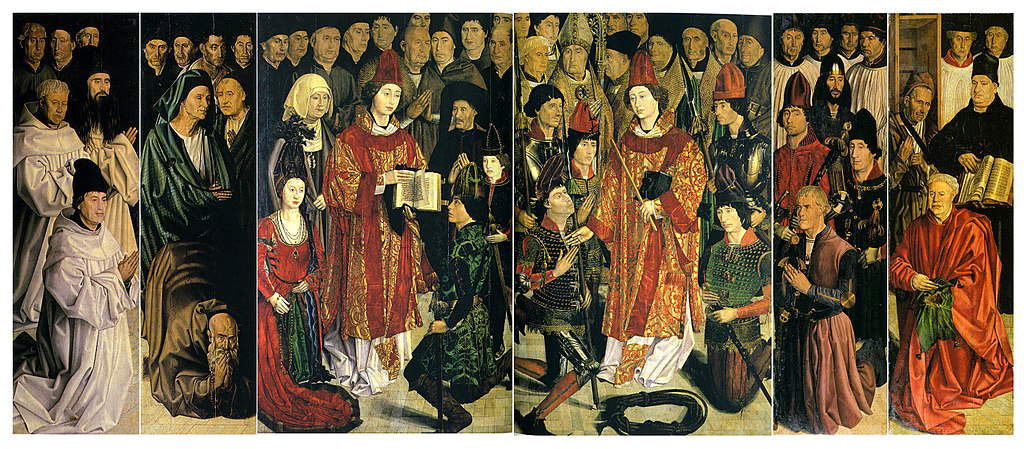 |
| Nuno Gonçalves, Polyptych of Sao Vicente (c. 1470; six panels measuring 207.2 x 64.2, 207 x 60, 206.4 x 128, 206.6 x 60.4 and 206.5 x 63.1 cm |
 |
| The Sao Vicente polyptych in restoration |
 |
| Portuguese Anonymous, Inferno (1510-1520; oil on panel, 119 x 217.5 cm; Lisbon, Museu nacional de arte antiga) |
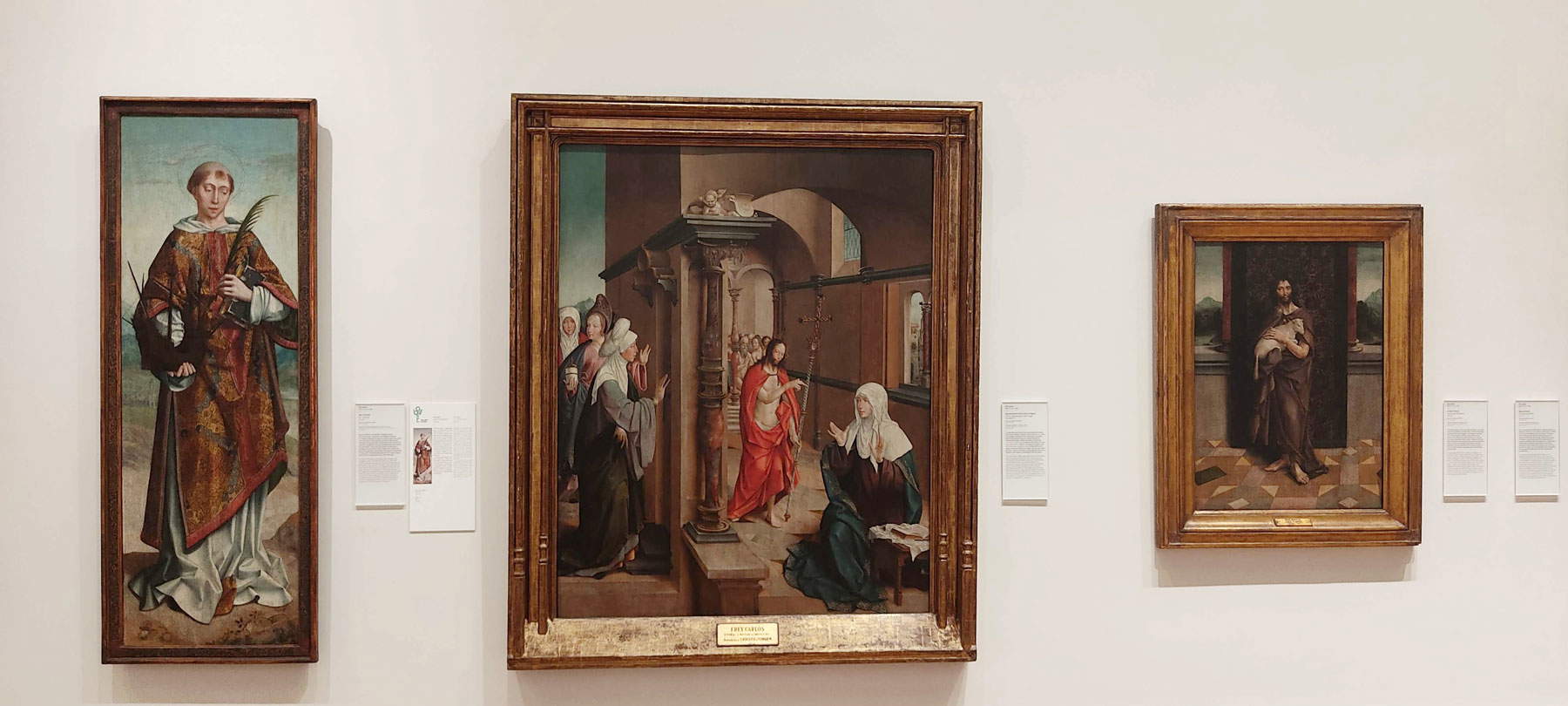 |
| Some paintings by Frey Carlos |
 |
| Frey Carlos, Calvary Triptych (1520-1530; oil on panel; Lisbon, Museu nacional de arte antiga) |
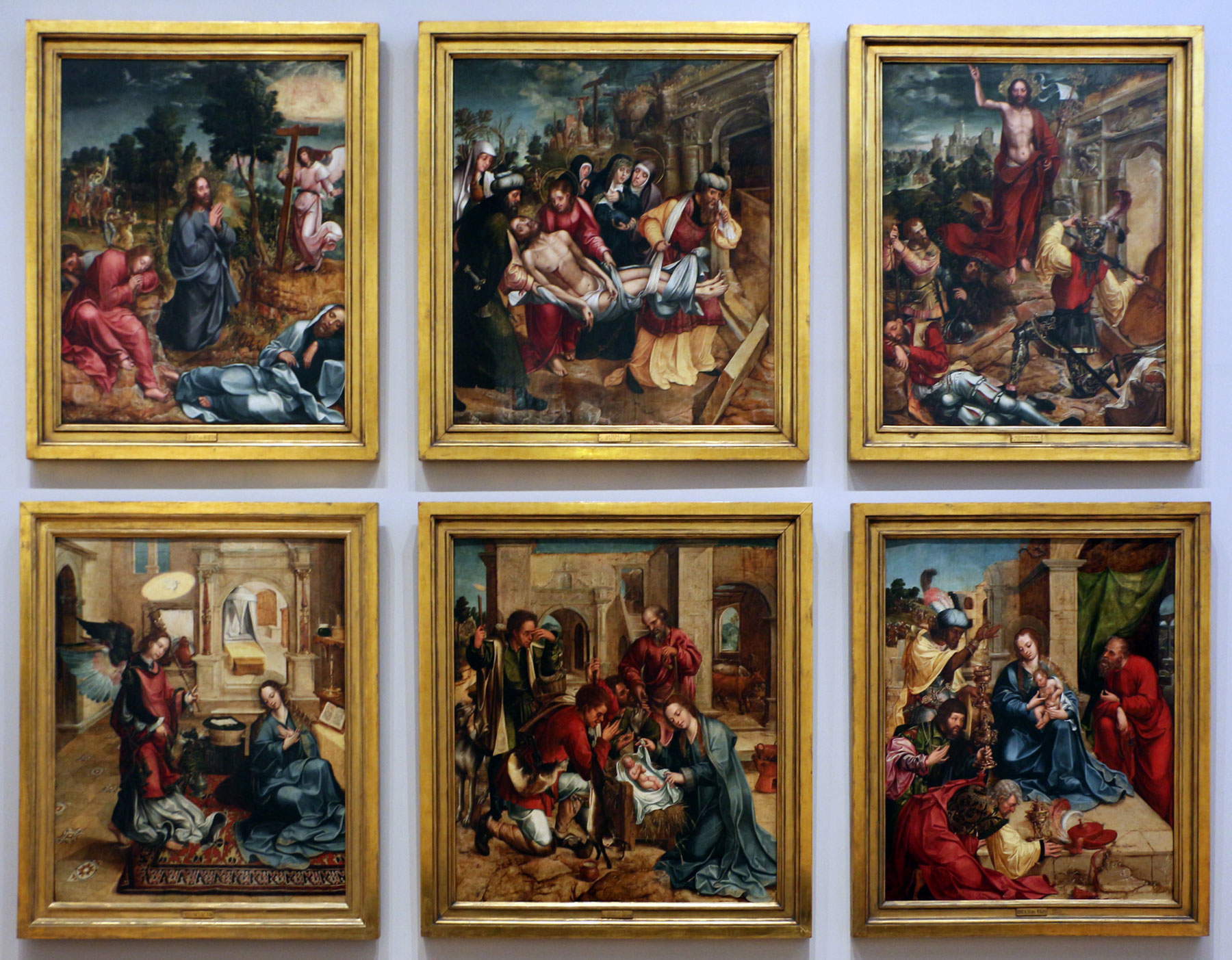 |
| Gregório Lopes, Altarpiece with Saints, c. 1540-45; Lisbon, Museu nacional de arte antiga) |
 |
| Gregório Lopes, Martyrdom of Saint Sebastian (1536-1539; oil on panel, 119 x 244 cm; Lisbon, Museu nacional de arte antiga) |
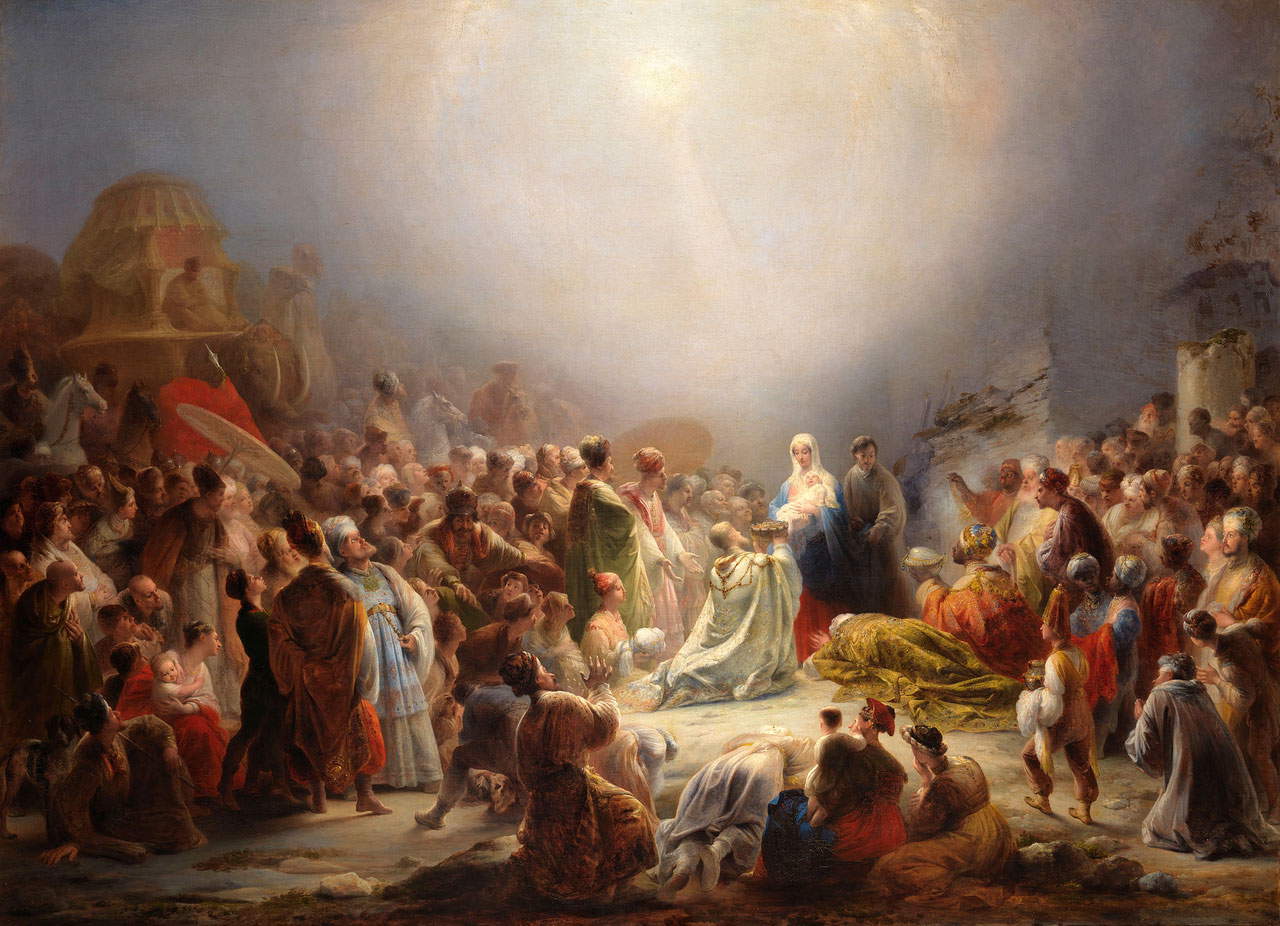 |
| Domingos Sequeira, Adoration of the Magi (1828; oil on canvas, 100 x 140 cm; Lisbon, Museu nacional de arte antiga) |
Also absolutely interesting is the highly personal painting of one of the major protagonists of the Portuguese Renaissance Grão Vasco (or Vasco Fernandes) with a more pronounced drawing, more akin to Italian than Flemish art. Slowly Portuguese painting became detached from Flemish painting, and the caesura became clear with the Counter-Reformation when Portuguese artists looked to Spain and indirectly to Italy. The Baroque season is also indebted to Italian art, but renounces naturalistic treatment and certain dramatic effects in the name of preciousness of color and decorative exuberance. Portugal’s most important neoclassical painter, Domingo António de Sequeira, also trained in Rome.
Embellishing a visit to the museum are the chapel of St. Albert that belonged to the convent, a jewel of color among stucco and gold-leafed woodwork and the shining blues of the azulejos; the Patiño Room, named after the Bolivian diplomat who donated it, a room in the Rococo style originally made for the Archduchess of Austria Marie Antoinette; and the beautiful elevated garden, overlooking the Tagus River and Lisbon’s harbor, with attached restaurant, cafeteria and study area.
The splendid museum, as well as a wondrous collection of art, is also a genuine refuge from the festive chaos of the Portuguese capital, and although it may not have the reputation of the great European museums, it retains enough to satiate the capital’s appetites and give more than one adventure, as Saramago claimed.
Warning: the translation into English of the original Italian article was created using automatic tools. We undertake to review all articles, but we do not guarantee the total absence of inaccuracies in the translation due to the program. You can find the original by clicking on the ITA button. If you find any mistake,please contact us.